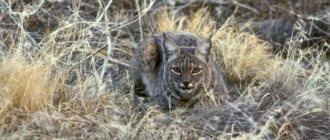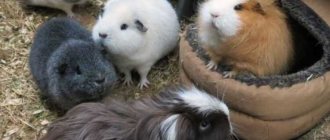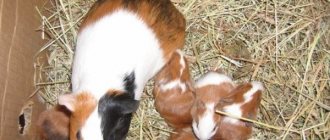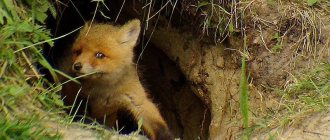- home
- Guinea pig
- General information about guinea pigs
02/11/2019 For many people, guinea pigs are charming pets; they often become full-fledged family members for their owner. But few people think about how these rodents live in natural conditions. Wild guinea pigs, of course, have different living conditions - no one cares for them or cares for them. These animals can only rely on themselves - they look for food themselves, arrange their homes themselves, and defend themselves from enemies. The characteristics of undomesticated guinea pigs and their living conditions will be discussed in this article.
Habitat
Let us repeat that the ancestors of modern domestic pigs still live in Latin America, where they are distributed almost everywhere. They can be found in swamps, plains, and rocky mountains.
Today there are several species of wild rodents, grouped under the common genus Cavia. Externally, the animals are very similar and only a specialist can distinguish them. Each of these species has its own territory on the mainland:
- Peru - Cavia tschudii,
- Andes valley - Cavia cutleri,
- Amazon River Basin,
- Brazil - Cavia aparea,
- Bolivia - Cavia fulgida.
Surprisingly, in each of these countries the animals are called differently: some locals call them cavia, others - gui, and still others - aparea.
National dish of Peru
Baked or fried guinea pig is a national treat in Peru. The dish is called “kui”. It is prepared on holidays, for guests or just as part of a regular dinner. It all depends on the side dish and sauces served. Before cooking a guinea pig, the animal's carcass is thoroughly washed, rubbed with spices and left in a cool place for an hour or two.
To prepare you need:
Mix flour with salt (half a teaspoon). Dissolve one tablespoon of salt and lemon juice in cold water. The guinea pig, previously sprinkled with pepper and salt, is placed in the marinade for another couple of hours. After the required period of time, the carcass is removed from the marinade, washed, sprinkled with black pepper and cumin, salted and breaded in flour. Heat the oil in a frying pan, put the guinea pig carcass in it, close the lid on top (preferably under pressure) and fry until a golden, even crust forms. In the same oil, fry chopped potatoes with onion rings. The finished guinea pig is served with chili, sprinkled with finely chopped onion and tomato, and with potatoes. For taste, you can sprinkle the meat with lemon juice.
Features of life
The active part of life takes place at dusk or early dawn; animals eat at night. During the day, wild guinea pigs prefer to hide in natural shelters. What exactly they will be depends on the local landscape:
- some dig holes in the ground, while the underground dwelling can turn into a real city with its own “streets” and “apartments”,
- others build houses from plants,
- still others find refuge in rocky crevices,
- and still others live in the wilds of thorny herbaceous bushes.
Under natural conditions, pigs eat exclusively plant foods:
- leaves and roots of trees,
- grass,
- stems,
- shoots and flowers.
A pet
Guinea pigs have long become perhaps the most familiar inhabitants of a living area.
They are very peaceful and fun to watch. Experts recommend keeping these animals in families (3 females and 1 male). You can have one animal, but then the owner must communicate with his pet more often, otherwise he will get bored. For several animals you need a fairly large cage, since each one needs a space of 40x40 centimeters. Cages with a deep plastic tray and a top made of metal rods are convenient. Sawdust or hay is placed in the tray as bedding. Guinea pigs produce a lot of urine, so bedding needs to be changed more often. The cage should be placed where there are no drafts, otherwise the pigs will often catch colds. They definitely need to build a house to sleep in. Every day the animals should be given the opportunity to run freely around the apartment. From lack of movement, they grow long claws, which, growing into the pads, cause pain. Pigs will feel comfortable in a house at a temperature of 16-18°C and a relative air humidity of 50%. If in the summer you can take your pet out onto clean country grass and give him the opportunity to graze, he will be very grateful to you.
Behavior
Guinea pigs never live alone. They create a social group consisting of one male and several dozen relatives (their number can reach up to 20, but not less than 10 individuals).
Each flock has its own territory, where outside pigs are prohibited from entering. The community carefully guards and preserves its habitat.
It would be difficult for them to survive alone - rodents have too many enemies in nature. In order to avoid falling into the clutches of predators, over the years of evolution a defensive line of behavior has been developed: while some are resting or feeding, others are observing their surroundings. In case of danger, the “guards” begin to squeak shrilly and signal an impending disaster. After a deafening siren, the rest of the group quickly hides.
Unlike domestic pets, wild rodents have virtually no odor. Their favorite pastime is licking, cleaning, and combing. They engage in grooming both independently and with the help of their relatives. A manic passion for cleanliness helps rodents mask their scent, making them virtually invisible to the keen sense of smell of predators.
Communication with each other occurs through sounds. Pigs grunt, purr, gurgle. All this expresses friendliness and disposition towards fellow tribesmen.
The behavior of aboriginal ladies is also significantly different from their domesticated “girlfriends”. In a pack, pigs never quarrel, but, on the contrary, are friendly and raise their offspring together.
Males are more aggressive. There is always a leader to whom everyone must obey unquestioningly. From time to time, skirmishes and fights occur between the “guys”: their goal is the same - to take a dominant position in the herd and displace the leader.
When a male with the makings of a leader fails to become the leader of a group, he leaves the pack and organizes his own clan.
Appearance
Pigs living in the wild are divided into several varieties that have common external characteristics with minor differences. Undomesticated rodents look somewhat different than their domesticated relatives.
On average, free rodents have the following body parameters:
- 25–35 cm long;
- weighing 0.8-1.2 kg for girl pigs and 1-1.5 kg for boy pigs.
However, animals of the Kui species, which have outstanding dimensions, can weigh twice as much.
In many ways, the animals resemble wild rabbits, only without long ears. The fur covering the entire body of the rodent is short and soft, gray-brown in color (black pigs are much less common).
The fur coat of wild animals is not as brightly colored as is often found on domestic pets. A red or white animal is an excellent target for predators. The plain color of wild rodents is due to the instinct of self-preservation - the brighter the color, the more problematic it is to hide.
It is also worth noting that the fur protects the animal not only from predators due to its color, but also from temperature changes due to its properties. The fur coat allows the animal to withstand both heat (but only within 45 °C) and cold (up to light frosts).
The head has the shape of an oval, medium-sized, but proportional to the body. The ears are small, erect, located closer to the back of the head, and their tips are devoid of hair. Large, usually dark, almond-shaped eyes set far apart.
The animal’s neck is barely noticeable, so it seems that after the head immediately come the shoulders and body. The body is powerful, tightly knit. The back is wide and flat. As for the paws, the hind paws are more developed than the front paws. The limbs of pigs are five-fingered.
The skeleton of wild pigs is strong. Their bones can even withstand falls from heights.
Climatic conditions
In nature, where guinea pigs live, the ideal living conditions are considered to be air temperature:
- from 7°C at night and in the evening,
- up to 22°C in the morning and afternoon.
Rodents can easily tolerate short-term heat above 30°C. They prefer to settle in places where it is not too hot and not very cold. There must be water, a source of food, and shelter on the territory of the settlement. Animals can live at different sea levels: both in the lowlands of the Amazon and in the highlands of the Andes.
Reproduction
Cavia females bear offspring 2 to 4 times a year. They can carry up to 8 piglets at a time. Mating often occurs in the summer, because at this time the weather conditions allow the babies to feel comfortable and grow. Little pigs begin to eat and walk on their own already on the 6th day, and after another week they become completely independent animals. Early independence is due to the presence of a sufficient amount of food, which is located near the nest, as well as the presence of teeth and warm fur.
Interesting facts about wild guinea pigs
Man began training pigs a very long time ago. They were kept not only to produce tasty meat, but were also used in various ritual rituals.
Among the ancient Indian peoples, the guinea pig was a cure for all diseases and served as a kind of x-ray. The custom of diagnosing human diseases with these pets in some Latin American countries has survived to this day.
Only black specimens are suitable for therapeutic purposes. The treatment method is simple - the patient is rubbed with mumps for two hours, after which the animal is killed and a diagnosis is made based on the altered internal organs.
How to properly arrange a cage
It is very important to choose and arrange the house for your pet correctly:
- Choose a cage of the right size, as structures often come across too small. A guinea pig requires a lot of space to fully move. Ideally, it is better to buy an enclosure for a guinea pig instead of a cage; the recommended area is 1 sq.m. for 1 animal.
In a small cage, a pet can get bored and get sick. Large cages will not only make good houses for pigs, but will also create comfort during cleaning.
- The instructions for choosing housing for a Guinea pet recommend allocating at least 60 cm² per pet, but taking into account that it should also accommodate a toilet, a nursery and a food bowl. Minimum requirements:
- 1 guinea pig – cage 75x90 cm.
- 2 animals – cage 75x125 cm.
- 3 pets – 75x155 cm.
- 4 pigs – 75x190 cm.
- It is important to decide where the structure will be located. It is not recommended to place your pet’s home in the kitchen or bedroom. When choosing a location, you should pay attention to the following factors:
- Temperature. There should not be a source of cold or hot air near the house. The ideal option is +23°C. It is best to place the cage away from window doors in a high place.
- Activity. The pet is very sociable at home and loves to be in the company of people; the living room is perfect for this. But at the same time, do not forget about the shelter in which the pet can hide for proper sleep and rest.
- Noise. Cavy is distinguished by acute hearing, which is why it is better to find a corner for the cage that is far from the TV, radio, or speakers.
- It is important to position the cage so that small children cannot reach it, scare the animal, or cause injury to it, the same goes for other pets.
- The inside of the pig's living space should be filled with straw or paper. You should not use pine or cedar sawdust offered in a pet store for this; they can harm your pet’s health. The layer should be about seven centimeters, it is changed regularly.
- Water is poured into a special drinking bowl, regularly changing it to fresh and clean water.
- The filler is changed regularly with light cleaning. Guinea pigs love cleanliness and dryness.
- It is better to choose a ceramic plate for food; it is difficult to turn over and does not bite. The bowl is placed away from the toilet filler.
- The cage is cleaned every day, general cleaning is done once a week.
- In the form of toys that a rodent must have, you can use wooden cubes, cardboard boxes, toilet paper, and a paper bag.
- You can hang a hammock, this idea will please your pet, but at first you need to observe how the pig copes with this element of the interior.
- In the cage there must be a quiet corner, closed from the outside world, in the form of a tunnel or canopy; you can purchase them at a pet store or make them yourself.
The cage should not contain things that could cause injury or death to the pet; this must be strictly monitored.
Fruit bats (aka flying dogs)
Scientists say that this species of bat is slowly dying out. But if the environment doesn't bother you, then go to Micronesia
-a state located on a group of small islands in Oceania.
It is there that these mice are caught, skinned, and then added to a broth with ginger and salt. The meat is quite dietary, and in different countries they believe that it increases potency and the chances of a long and active life, improves vision and treats rheumatism, arthritis and even cough.
If you can’t find tickets to Micronesia, don’t despair - you can try bats in China, India, and Indonesia
and in the
Philippines
.
Notes[ | ]
- Sokolov V. E.
Five-language dictionary of animal names. Mammals. Latin, Russian, English, German, French. / under the general editorship of academician. V. E. Sokolova. - M.: Rus. lang., 1984. - P. 196. - 352 p. — 10,000 copies. - ↑ 1 2 Bram A.E.
Animal life. - M.: Olma-Press, 2001. - P. 240. - 1192 p. — 5000 copies. — ISBN 5-224-04422-7. - Altman, 1999, p. 5.
- Morales, 1995, p. 3.
- Chazan M.
World Prehistory and Archaeology: Pathways through Time. - Allyn & Bacon, 2008. - P. 272. - 544 p. — ISBN 0-205-40621-1. - Morales, 1995, p. 3-4.
- The Spirit of Ancient Peru: Treasures from the Museo Arqueologico Rafael Larco Herrera. - Thames & Hudson, 1997. - 216 p. — ISBN 0500018022.
- Nowak, Ronald M.
Walker's Mammals of the World (unspecified). — 6th. - Baltimore, Md.: Johns Hopkins University Press (English) (Russian, 1999. - P. 1667-1669. - ISBN 0-8018-5789-9. - Juan de San Martin and Antonio de Lebrija.
Report on the conquest of the New Kingdom of Granada and the founding of the city of Bogota (July 1539).
(unspecified)
(inaccessible link). www.kuprienko.info (A. Skromnitsky) (April 4, 2010). Access date: April 4, 2010. Archived January 11, 2012. - Pedro Cieza de Leon.
Chronicle of Peru.
Part Two: The Dominion of the Incas. (undefined)
. www.kuprienko.info (A. Skromnitsky) (January 14, 2009). Access date: October 5, 2009. - Diego Gonzalez Holguin.
Dictionary of the Quechua Language (1608).
(undefined)
. www.kuprienko.info (A. Skromnitsky). Access date: October 13, 2009. Archived August 20, 2011. - ↑ 123
Inca Sources, 2013. - Can guinea pigs have dill, parsley and other greens?
- Why does a guinea pig eat its own excrement - a pathology study (unspecified)
. - Diseases of Domestic Guinea Pigs, Second Edition - Richardson - Wiley Online Library
- How to trim a guinea pig's claws
- Science and life. - 2012. - No. 5. - P. 109.
Silkworms
In Asia, they don't see anything strange in eating insects: in most countries in the south-eastern region, you will find stalls on the streets with grasshoppers, cockroaches and other jumping and crawling (in the past) snacks. Although silkworms are more often used to produce silk.
But here are the chefs from South Korea
decided not to waste resources (after receiving the silk, the larvae are usually thrown away) and began to fry or boil them with spices to get an excellent snack.
If you want to try it, ask the street food stalls for the “bondegi”
. But be careful: the larvae taste quite bitter and burst when bitten.
Top 10: Animals eaten in other countries
We love meat very much - maybe even excessively. However, as a recent example from the US shows, people only like certain types of meat: when the US Department of Agriculture wanted to approve a horse meat plant, people did not approve. Yes, conditions in meat processing plants are terrible for other common animals, and horses are “companion animals,” but in other countries, more distant from Western civilization, horses are bred for meat.
However, if you also think that horses are an unfortunate delicacy, you will be surprised to know what kind of meat is a common dish in other countries. Vegetarians, look away...
10. Iguana
Yes, people eat iguanas. This is a traditional dish in some areas of Mexico and Central America, plus the meat of iguanas is very rich in vitamins, and tastes like chicken (which, interestingly, does not taste like chicken?) Most often, people eat ordinary iguanas, ctenosaurs and black iguanas.
True, the sale of iguanas in the United States is prohibited, but due to Florida's lax laws, they are imported as exotic pets and become annoying pests. They dig under sidewalks, climb into attics and eat endangered flora and fauna, so this could change the "protected" status of iguana meat very quickly.
9. Turtles
Everyone has heard of turtle soup, and everyone has also heard that some species of turtles carry salmonella. However, as with any pet (or food in this case), if they are taken care of and washed properly, turtles can be eaten. If you love delicacies, you can find plenty of turtle recipes online to please gourmet taste buds.
Although they are very popular in Central America and Asia (sea turtle eggs are considered an excellent aphrodisiac), turtles are mainly a staple in Chinese medicine: they are believed to hydrate, nourish and support the kidneys and blood, as well as relieve menopausal symptoms. Yes, you heard right, menopause symptoms.
8. Guinea pigs
Guinea pigs? Nooo, not our cute furry pets! Unfortunately, in some parts of South America, guinea pigs are a fairly popular meat, which is said to be healthier than beef (it feels like everything is healthier than beef) and tastes like lamb.
In Peru alone, about 65 million guinea pigs are consumed annually. And why not? They are easy to feed, easy to breed (a female guinea pig can give birth to 3-5 litters per year, each of which will have from 1 to 6 cubs), and also take up less space than regular livestock. In fact, Peruvians think we are crazy for keeping them as pets. And considering that they can cost up to $50 (not including food, cages and other things to keep guinea pigs), maybe they're right.
7. Emu
Emus are known for several things: they are the second largest bird in the world, are native to Australia, and their name is a lot of fun to say. However, if you believe emu connoisseurs (it turns out that such people exist), emu is a rare combination of taste and healthfulness. Emu meat is dietary, low in cholesterol, rich in iron and vitamin C, and tastes similar to sirloin steak. Despite being considered a delicacy among the tribes of Australia, for some reason the rest of the world has not appreciated this meat. Maybe everyone was laughing so hard at the name of these big birds that they forgot that they had to eat dinner.
6. Larvae
While the thought of eating grubs will cause most people to look around for a convenient bag to throw up, grubs are almost entirely protein and are very nutritious. They are eaten in parts of Africa, and of course in China. In addition to the fact that larvae can be a main dish, they are also useful in medicine - they can be used to determine the moment of death of a person, with their help you can get rid of rotten meat and waste, and they are also used in the production of cheese in Sardinia (and eaten together with cheese).
5. Camels
Oddly enough, camel meat has been consumed for centuries. The ancient Greeks wrote that camel meat was served at Persian banquets, and in the form of a whole roasted animal. The Roman Emperor Heliogabalus loved camel hooves. Apart from Heliogabalus, most people prefer the brisket, ribs and loin of camels, and their hump is considered a special delicacy. The hump of camels contains “white and sweet fat”, which can be used to preserve other meats - lamb, beef and camel. Although camel meat is quite tough meat, the longer you cook it, the more tender it becomes.
Camel meat is commonly consumed as an alternative source of protein in arid countries such as Djibouti, Somalia, Saudi Arabia and Kazakhstan. In Kenya, camel blood is mixed with milk to obtain iron, vitamin D, salt and other minerals. The Abu Dhabi Officers' Club mixes beef or lamb fat with camel meat to create burgers, and in Alice Springs, Australia you can enjoy camel lasagna. Just don't tell Garfield.
4. Dolphins
Although dolphin hunting occurs in a small number of places (coastal cities in Japan, the Faroe Islands and the Solomon Islands), the practice is frowned upon in the rest of the world, not least because dolphin meat contains high concentrations of methylmercury. Although all fish contain mercury, dolphins have too high levels of mercury due to the fact that they feed on other marine animals that contain mercury, and it accumulates in their bodies over the 18 to 50 years of their lives.
3. Cassowaries
Cassowaries are a species of large bird related to ostriches and emus, endemic to the forests of New Guinea and other islands northeast of Australia. And according to the Korowai people of southeastern Papua, cassowary meat tastes very similar to human flesh. Although cannibalism is not a big part of their culture as in other tribes, any person accused of being a kakua (secret sorcerer) will be ritually eaten. So they know what we taste like. The truth is, in fact, this is all very complicated - after all, most cassowaries are considered to be under threat of extermination, and cannibalism is an illegal activity. However, this will not stop adventurous (crazy) people from trying these types of meat. And if anyone is “brave” enough to try human and cassowary meat, tell us your impressions in the comments. And don’t forget to indicate your address so that we can send a police squad to you.
2. Dogs
Everyone knows that in China, Vietnam, South Korea and other Asian countries they eat dogs. As it turns out, dogs were eaten in Ancient Rome, Ancient Mexico and Ancient China. Now the practice is common in Switzerland, and even US President Barack Obama has tried dog meat.
While some consider dog meat a traditional dish, others consider it inappropriate and even blasphemous. Eating dogs is prohibited in both Judaism and Islam, and in Buddhism, dog meat is one of the “five forbidden meats.” Dog farmers, on the other hand, do not consider it any different from raising other livestock. And you decide for yourself - if in doubt, reconsider White Bim.
1. Jellyfish
People all over the world eat octopus and squid, but are jellyfish safe to eat? Technically, yes. Of the 85 known species of jellyfish, 12 can be eaten. They are primarily found in Southeast Asia, but due to the popularity of American cornet, they are also found in the North Atlantic Ocean and Gulf of Mexico and are eaten in China and Japan.
The preparation takes 20-40 days and is carried out by a man with the cool title of “jellyfish master”. During preparation, the gonads and mucous membrane are removed, and the dome and tentacles are treated with alum solution and table salt. After this, compression is used, which reduces odor, liquid content and harmful organisms. The result is a crispy, brittle dish. Even though jellyfish are 94% water and 6% protein, they contain almost no cholesterol, carbohydrates or saturated fat. Unfortunately, jellyfish meat can contain the same bacteria as all other types of meat. And yet, it is very interesting to learn that some types of jellyfish are edible and not poisonous.
Support Bugaga.ru and share this post with your friends! Thank you!











